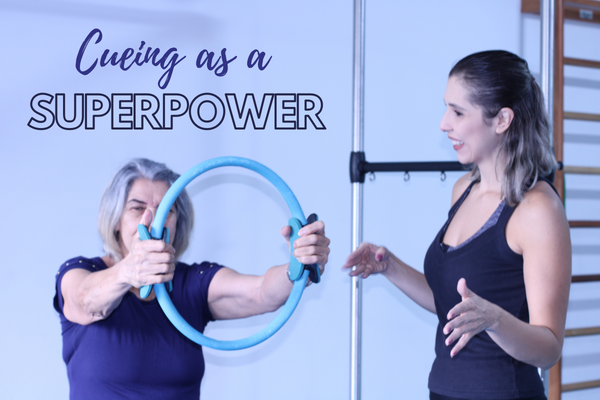
Unknown origins
The origin of the word “cue” is somewhat unknown, but it is likely to come from the Latin word “quando”, which means “when”. In movement practices, such as Pilates, cueing is a way to get clients moving so they get the most out of an exercise. But have you ever felt that your words aren’t reaching your clients as intended? Ever wonder why your method of communication seems clear and precise to you but not necessarily to your audience?
Cueing – A skill to master
Cueing is a crucial skill for teachers; mastering its art requires the same dedication as studying the method and the exercises within the system. Learning the Pilates method is more than memorising a list of exercises for the different pieces of apparatus. The never-ending journey to deeply understand the system happens gradually with experience (practice and teaching), curiosity and intelligence. The same applies to the way the work is verbally presented and instructed: the correct words said at the right time with the right intention are key to getting clients moving, teaching a new exercise, creating awareness, deepening, refining a movement or even bringing back wandering minds to the task at hand.
What makes a cue powerful?
We’ve already established that a cue’s initial purpose is to indicate the start of an action. The next step is to target the element we want to see the most in the exercise. A concise cue delivered positively makes all the difference. I emphasise the positive. Too often, teachers are quick with the “don’t” instructions. For example: “Don’t roll your shoulders in” instead of “keep the front of your shoulder open”. Both have the same intended result, but the response to the words is different. The first points out what the client is doing incorrectly, and a series of “don’t” in a session can leave the client with a sensation of inadequacy. The latter confidently creates a challenge and provokes awareness. It tells the client; I know that you can do this and now prove me right.
Make it personal and create a link between some exercises and your clients’ daily activities.
Keep it to yourself
Jay Grimes maintains and often blurs out: “Teachers, you talk too much”. It is true many teachers talk and correct too much. Keep some to yourself; clients don’t need to be told everything. And not all things need to be corrected at once. A verbal pause from a teacher can have a big impact.
Joe Pilates used few words. His limited English skills and strong German accent had a lot to do with this, however, it also meant that his words had an undeniable power. When spoken, they really meant something. So, bring out your inner Joe (perhaps minus his notorious grunting technique).
Practice self awareness
Be aware of common teaching patterns that can impact the intention and effectiveness of cueing. These habits can lead to clients tuning out and consequently will leave teachers a little frustrated and underwhelmed. There are many of them, here a few to watch out for:
Security blanket words: The auto-repeat cues like “scoop” or “shoulders down” or words like “excellent” or “good”; before saying them out loud, ask yourself, is it relevant to what I see or want to see?
Poor timing in delivery: Was the cue to early? Or too late? Knowing and teaching the rhythm of the exercise from the beginning helps with timing the cues at the right moment.
Non-stop talking: Taking a breath in to observe briefly and quietly what is happening helps for more impactful cueing and it is less exhausting for the vocal cords.
Looking for perfection: It does not need to be perfect. Providing it is safe, it is ok to make mistakes. Pilates is a movement system, keep them moving. Pick one correction per exercise or perhaps none for some, giving your clients a chance to work some things out on their own.
Use your cues as a superpower to challenge, to create an intent, to set a goal however big or small. Be creative with your words to help your clients’ understanding and perhaps even capture their interest.
Keep it simple; Keep it short; Keep it positive; make it fun and exciting for your clients and yourself.
Eve Fairbairn, PAA Committee Member

Comments are closed.